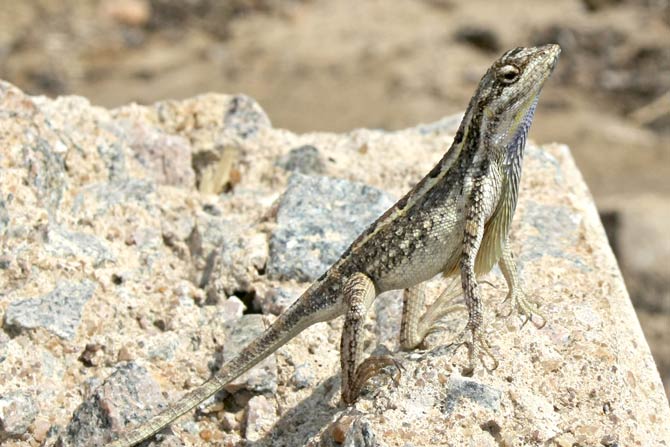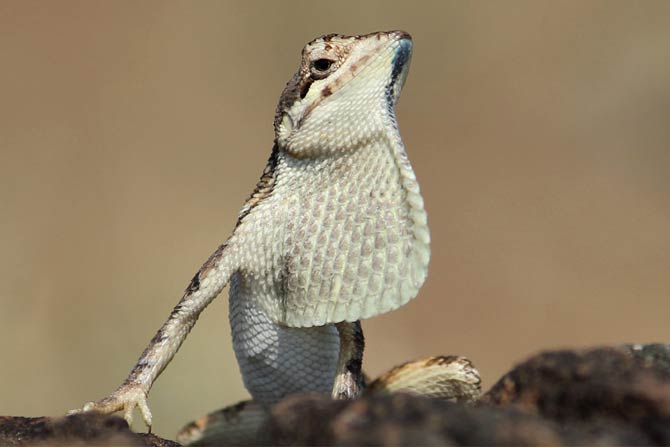In what can be described as an important discovery in the field of wildlife and nature conservation, two well-known researchers Dr Varad Giri along with Dr V Deepak have discovered one new genus and five new species of fan-throated lizards in India

In what can be described as an important discovery in the field of wildlife and nature conservation, two well-known researchers Dr Varad Giri along with Dr V Deepak have discovered one new genus and five new species of fan-throated lizards in India.
ADVERTISEMENT
Their scientific paper was recently published in a journal 'Contributions to Zoology'.
 A new species of lizard
A new species of lizard
According to the researchers, "India has a rich diversity of amphibians and reptiles and more than 50% species are endemic to this region. It should be noted that the present knowledge about the diversity of amphibians and reptiles in India is mainly based on the studies conducted prior to independence.

"This was one of the highly neglected groups of vertebrates in term of their studies until recently. But the last two decades has seen a progressive change as many researchers and scientists dedicating their efforts towards assessment of this poorly known group resulting in many new discoveries. Most of these studies are concentrated in the biodiversity rich regions like Western Ghats and northeast India. But recent efforts in the barren dry zones of India, resulted in the discovery of one new genus and five new species of Fan-throated Lizards. These landscapes, which are traditionally thought to be poor in species richness, are abode to vast underestimated diversity of reptiles, especially lizards.” Said Dr Varad Giri.

Fan-throated lizards are small sized agamids, many of which will fit on our palm and are only known from South Asia. The first species of fan-throated lizard Sitana ponticeriana was described by the renowned French Naturalist and father of Paleontology, Georges Cuvier in 1829 from Puducherry, India. Since then five other species were described from Nepal and Sri Lanka.
“In India they are reported from most of the states but represented by only two species. This was unlikely, given the vast and heterogenous landscapes and ecological factors. With this rational, an intensive sampling was conducted in various places in India. The sampling was also done in the type localities of the known species. The specimens were properly identified using molecular and detailed morphological techniques. This was a first attempt of this kind in India with such fine scale sampling and use of an integrated approach to address a problem pertaining to the widely distributed species of reptiles. This resulted in the discovery of one new genus and five new species of Fan-throated lizards in India.” Giri said.
This was a collaborative effort with experts from various places in India. A study was conducted by team of scientists lead by Dr. V. Deepak, Post Doctoral Fellow from Center for Ecological Sciences (CES), IISC, Bangalore. It was his idea and Dr. Deepak conducted field sampling and molecular work under the supervision of Dr. Praveen Karanth of CES, who is one of the authors in this paper. Dr. Varad Giri from National Centre for Biological Sciences (NCBS), Bangalore mostly did the taxonomy and species description. The other co-authors on this paper Dr. S.K. Dutta, Mohammad Asif, Raju Vyas, Amod Zambre and Harshal Bhosale equally contributed to this study.
One of the major finding of this study was a description of a new genus Sarada, a distinct sister group to Sitana. One of the known species Sitana deccanensis belongs to this new genus. Along with this two new species Sarada superba and S. darwini are newly described. The lizards of this genus are only known from some parts of Maharashtra and north Karnataka.
Sarada darwini is a species found only in southern Maharashtra and North Karnataka. They also breed during the South-west monsoon. They are very common in some of the cotton fields in this region and when approached dive into the deep cracks in the black soil. They are one of the most brightly coloured Indian lizards. It is named in honour of Charles Darwin who used these lizards as one of the example for his studies on sexual selection.
Sarada superba is a species so far found only in Chalkewadi, a high elevation plateau in Satara district, Maharashtra. They also breed during the South-west monsoon. They are very common in this plateau and when approached they escape into the cracks in lateritic substrate. They are as brightly coloured as Sarada deccanensis. It is named after its dramatic displays and large dewlap. “Superbus” in latin means magnificent.
The other findings are the description of three new species of Sitana and redescription of known species from India. The new species Sitana spinaecephalus is one of the most wide-spread species in this genus. It’s distribution ranges from Ajmer of Rajasthan state in the North to Badlapur of Maharashtra state in the South and Kutch of Gujarat state in the West, Chandrapur of Maharashtra in the east. They breed during the south-west monsoon. It has a very plain yellowish white dewlap with a single blue line on the lower jaw. It is named after the four prominent spines on the back of it’s head. “Spinae” is Latin for spine and “Cephalus” Greek for head.
The second new species Sitana laticeps is with limited distribution in the hilly tracts of Western Maharashtra. They have a very small dewlap compared to its sister species Sitana spinaecephalus but they both have similar dewlap colours. They also breed during the south-west monsoon. It is named after its broad head. “Latus” means broad and “Ceps” means head in Latin.
The third new species Sitana visiri was found very commonly in Tuticorin in the coastal grassland in Tamil Nadu. They breed during the North-east monsoon and males have a iridescence white, blue and orange dewlap during breeding season. It is named after the fan made out of palm leaf in southern Tamil Nadu called “Visiri”
Since some of the species are morphologically similar looking the authors used multiple lines of evidence (morphology, osteology and genetics) to delimit species in this species complex.
This study highlights the need of conducting intensive studies in arid landscapes, which appear to abode a cryptic diversity of lizards.
 Subscribe today by clicking the link and stay updated with the latest news!" Click here!
Subscribe today by clicking the link and stay updated with the latest news!" Click here!






